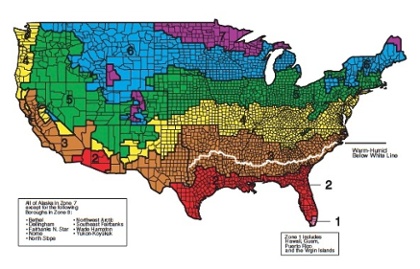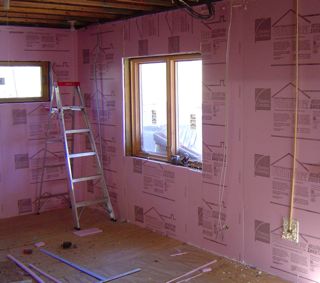Using Building Science to Transform a Damp, Musty Basement

 “In this house, we obey the laws of thermodynamics!” Homer Simpson said that, and it’s good advice for all of us. Actually, we don’t really have a choice, you know. If, out of ignorance or dissent, we do things that go against the laws of thermodynamics or physics or building science, we don’t break the laws. But they sure can break us — and our buildings!
“In this house, we obey the laws of thermodynamics!” Homer Simpson said that, and it’s good advice for all of us. Actually, we don’t really have a choice, you know. If, out of ignorance or dissent, we do things that go against the laws of thermodynamics or physics or building science, we don’t break the laws. But they sure can break us — and our buildings!
“In this house, we obey the laws of thermodynamics!” Homer Simpson said that, and it’s good advice for all of us. Actually, we don’t really have a choice, you know. If, out of ignorance or dissent, we do things that go against the laws of thermodynamics or physics or building science, we don’t break the laws. But they sure can break us — and our buildings!
Yesterday, I described the building science issues in the damp, musty basement of my condo building that resulted from the designers and builders not understanding the principles of building science. Today, I’ll describe what I’m proposing to the community to fix it.
Before I get into the details, though, let me tell you about the document I learned a whole lot of building science from. It’s called Read This  Before You Design, Build or Renovate by Joe Lstiburek, founder of Builder Science Corporation. (You can download the full 52 page document by clicking the title above or the image to the right.) It’s one of the best explanations of building science and building details I’ve come across in the past decade. BSC is an amazing source of building science info, and if you want to learn building science, go mine their website. (You may recall that they hold an event every August referred to Building Science Summer Camp, which you can read about in my article, I Don’t Need No Stinkin’ Building Science Summer Camp.)
Before You Design, Build or Renovate by Joe Lstiburek, founder of Builder Science Corporation. (You can download the full 52 page document by clicking the title above or the image to the right.) It’s one of the best explanations of building science and building details I’ve come across in the past decade. BSC is an amazing source of building science info, and if you want to learn building science, go mine their website. (You may recall that they hold an event every August referred to Building Science Summer Camp, which you can read about in my article, I Don’t Need No Stinkin’ Building Science Summer Camp.)
OK, now let’s get to that basement renovation I’m proposing. Recall that the main problems are
- High relative humidity
- Air leakage into the conditioned space above the basement
- Ineffective insulation in the floor above the basement
Climate-Appropriate Solutions
One of the most important principles of building science is to design, build, and renovate using methods and materials appropriate for your climate. We’re in a mixed-humid climate here in Atlanta, Georgia, so we have to worry about the outdoor humid air in summer and not so much about really cold surfaces in winter. Yes, most of us here pay more to heat our homes than to cool them, but our winter design temperature is 23° F. With a winter design temperature of -9° F, someone in Minneapolis would have to do things differenly than what I’m recommending below.

Controlling Moisture
The water vapor comes mainly from the crawl space vents installed in the foundation walls and from moisture evaporating from the  foundation walls themselves. To solve the first problem, we’re going to seal up the vents to isolate the basement air from outside air.
foundation walls themselves. To solve the first problem, we’re going to seal up the vents to isolate the basement air from outside air.
Dealing with the walls is the tricky part. What we’re going to do is install extruded polystyrene (XPS) rigid foam insulation to the walls. The 1″ thick XPS has a perm rating of about 1, which will still allow moisture to move through and dry to the interior. You have to make sure you get the right foam board, though. Some XPS comes with a membrane that allows it to be used as a drainage plane when installed as exterior wall sheathing, and that membrane drops the perm rating to about 0.2. We want the higher perm rating so the walls can dry to the inside.

The basic rules for water management in buildings are:
- Don’t trap water in building materials or assemblies.
- Allow materials and assemblies to dry to at least one side.
We don’t have bulk water problems right now, so I think we can get away with putting foam board on the walls without putting in a drainage system. We’ll leave the foam board about an inch off the floor at the bottom, so if for some reason water does start collecting and draining behind the foam board, we’ll be able to see it and deal with it then. We’re leaving the slab exposed and won’t have a bottom plate against the walls to hide the water if that does happen.
Controlling Air
By sealing up the crawl space vents in this basement and putting XPS foam board insulation on the foundation walls, we’re moving the building envelope from the framed floor above the basement to the foundation walls and slab. We’ll do a much better job of controlling heat, air, and moisture flows this way, but we still need to provide some type of conditioning for the air in the basement. We’ll do that with dehumidifiers. We don’t really care about controlling the temperature down there the way we do in conditioned space, so all we need is dehumidification, and one dehumidifier on each end of the basement should do the trick.
Adding foam board insulation to the foundation walls solves the problem of ineffective fiberglass insulation in the framed floor above, too, so we’ll pull it out. That will give us access to the air leakage sites in the floor, so we can seal them up. Even though the air in the basement will be much better, it’s best to isolate the basement from the conditioned space above.
Dealing with damp basements isn’t that hard when you understand the two rules of moisture management above, but a lot of buildings have it wrong. I’m hoping we’ll get this work done next year, so I’ll post an update here if and when that happens.
This Post Has 9 Comments
Comments are closed.

Very informative!
Very informative!
Know a couple of good sources for proper installation and drainage of dehumidifiers?
Dri-Eaz and Phoenix make
Dri-Eaz and Phoenix make dehumidifiers with pumps and tubing to get the water out, but the ones used by SERVPRO for restoration don’t have any feature that stops the dehumidifier if the humidity gets below some desired level.
Allison, I’m curious, in a
Allison, I’m curious, in a case like this would you consider painting the block walls with dry-lock first to control the moisture diffusing through, and then the XPS for the thermal boundary? Is the 1 perm of the XPS what you feel is best for stopping diffusion, but allowing some drying?
Thanks to both of you. Just
Thanks to both of you. Just what we needed. Basement below grade, but one of these can work.
Condo Neighbor, I’d suggest
Condo Neighbor, I’d suggest the dehumidifier owner’s manual for installation and drainage instructions. I believe most dehumidifiers give you the option of having a continuous drainage system instead of having to empty the tank. If that’s what you want, then you need to install the dehumidifier in a place where it can drain by gravity to the outside or to a drain. If that’s not possible, then you hook it up to a small condensate pump, the type used with air conditioners that can’t use gravity to drain the condensate.
Hunter, I’m torn about using
Hunter, I’m torn about using an interior sealant. We do have some efflorescence but no bulk water coming through the walls. My thoughts about this are that by sealing the walls, we might be driving moisture upward to the framing, and there’s no capillary break between the foundation wall and the sill plate. The foam board will slow down the evaporation of water vapor into the basement but still allow the walls to dry somewhat.
On the other hand, I just read on Home Energy Pros about one person who uses a product called RadonSeal. Maybe it’s best to do some wall and floor sealing here, too.
Do you have any good resources for helping to decide whether to seal or not?
You bring up a good point
You bring up a good point with the lack of capillary break, and likely not one at the footing either. Depending on how much of the wall is exposed on the exterior and what the finish is, the drying might happen there instead. I believe The perm of DryLock is about the same as the XPS, but you could get continuous coverage that is adhered to the wall (no gaps etc.).
There was a discussion about this a while back on the GBA site, started by someone in your area. Check it out, my advice was to give you guys a call!
http://www.greenbuildingadvisor.com/community/forum/energy-efficiency-and-durability/18364/controlling-humidity-unfinished-block-wall-ba
(Sorry, I’m not HTML savvy and don’t know how to post a true link here)
Ran across this article on
Ran across this article on GBA. Holladay says that Joe L has recanted his statement that basement/foundation walls must be able to drive to the interior.
http://www.greenbuildingadvisor.com/blogs/dept/musings/joe-lstiburek-discusses-basement-insulation-and-vapor-retarders
I was considering installing
I was considering installing a WAVE system when I read some negative comments and instead installed a radon fan (165cfm)using 4.5 inch PVC pipe. My humidity went from 60 to 73 in two days so I unpluged the fan. The humidity after two days of the fan being unplugged is down to 67. Where did I go wrong?